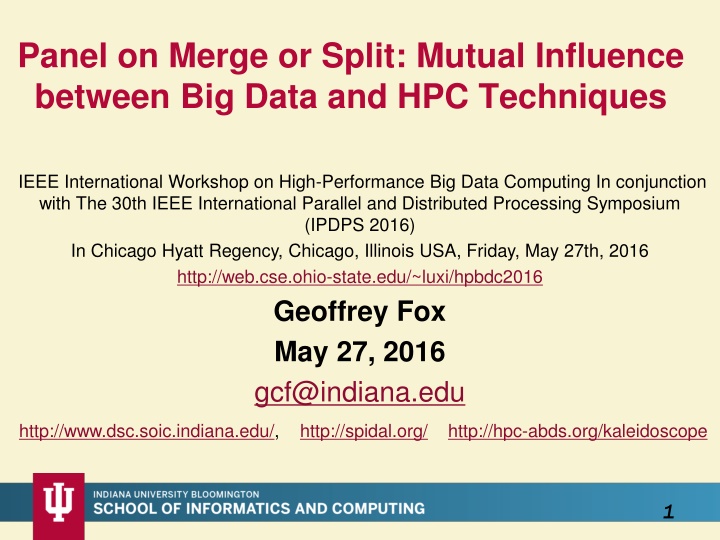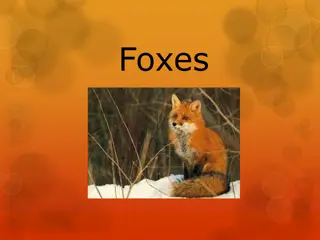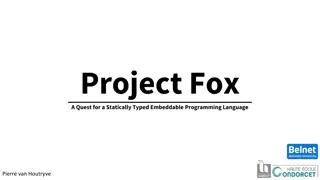
Mutual Influence of Big Data and HPC Techniques: Panel Discussion Insights
Discover the impact of Big Data and HPC techniques on each other, future mutual influences, and a kaleidoscope of ABDS and HPC technologies discussed at the IEEE workshop. Explore topics ranging from software sustainability to high-level programming and application hosting frameworks.
Download Presentation

Please find below an Image/Link to download the presentation.
The content on the website is provided AS IS for your information and personal use only. It may not be sold, licensed, or shared on other websites without obtaining consent from the author. If you encounter any issues during the download, it is possible that the publisher has removed the file from their server.
You are allowed to download the files provided on this website for personal or commercial use, subject to the condition that they are used lawfully. All files are the property of their respective owners.
The content on the website is provided AS IS for your information and personal use only. It may not be sold, licensed, or shared on other websites without obtaining consent from the author.
E N D
Presentation Transcript
Panel on Merge or Split: Mutual Influence between Big Data and HPC Techniques IEEE International Workshop on High-Performance Big Data Computing In conjunction with The 30th IEEE International Parallel and Distributed Processing Symposium (IPDPS 2016) In Chicago Hyatt Regency, Chicago, Illinois USA, Friday, May 27th, 2016 http://web.cse.ohio-state.edu/~luxi/hpbdc2016 Geoffrey Fox May 27, 2016 gcf@indiana.edu http://www.dsc.soic.indiana.edu/, http://spidal.org/ http://hpc-abds.org/kaleidoscope 1
Panel Topics What is the impact of Big Data techniques on HPC? Software sustainability model from Apache community Functionality in data area from streaming to repository to NOSQL to Graph Parallel computing paradigm useful in simulations as well as big data DevOps gives sustainability and interoperability What is the impact of HPC techniques on Big Data? Performance of mature hardware, algorithms and software Future mutual influence between HPC and Big Data techniques? HPC-ABDS(Apache Big Data Stack) Software Stack; take best of each world Integrated environments that approach data and model components of Big data and simulations; use HPC-ABDS for Exascale and Big Data Work with Apache and Industry Specifying stacks and benchmarks with DevOps 5/17/2016 2
Kaleidoscope of (Apache) Big Data Stack (ABDS) and HPC Technologies 17) Workflow-Orchestration: ODE, ActiveBPEL, Airavata, Pegasus, Kepler, Swift, Taverna, Triana, Trident, BioKepler, Galaxy, IPython, Dryad, Naiad, Oozie, Tez, Google FlumeJava, Crunch, Cascading, Scalding, e-Science Central, Azure Data Factory, Google Cloud Dataflow, NiFi (NSA), Jitterbit, Talend, Pentaho, Apatar, Docker Compose, KeystoneML 16) Application and Analytics: Mahout , MLlib , MLbase, DataFu, R, pbdR, Bioconductor, ImageJ, OpenCV, Scalapack, PetSc, PLASMA MAGMA, Azure Machine Learning, Google Prediction API & Translation API, mlpy, scikit-learn, PyBrain, CompLearn, DAAL(Intel), Caffe, Torch, Theano, DL4j, H2O, IBM Watson, Oracle PGX, GraphLab, GraphX, IBM System G, GraphBuilder(Intel), TinkerPop, Parasol, Dream:Lab, Google Fusion Tables, CINET, NWB, Elasticsearch, Kibana, Logstash, Graylog, Splunk, Tableau, D3.js, three.js, Potree, DC.js, TensorFlow, CNTK 15B) Application Hosting Frameworks: Google App Engine, AppScale, Red Hat OpenShift, Heroku, Aerobatic, AWS Elastic Beanstalk, Azure, Cloud Foundry, Pivotal, IBM BlueMix, Ninefold, Jelastic, Stackato, appfog, CloudBees, Engine Yard, CloudControl, dotCloud, Dokku, OSGi, HUBzero, OODT, Agave, Atmosphere 15A) High level Programming: Kite, Hive, HCatalog, Tajo, Shark, Phoenix, Impala, MRQL, SAP HANA, HadoopDB, PolyBase, Pivotal HD/Hawq, Presto, Google Dremel, Google BigQuery, Amazon Redshift, Drill, Kyoto Cabinet, Pig, Sawzall, Google Cloud DataFlow, Summingbird, Lumberyard 14B) Streams: Storm, S4, Samza, Granules, Neptune, Google MillWheel, Amazon Kinesis, LinkedIn, Twitter Heron, Databus, Facebook Puma/Ptail/Scribe/ODS, AzureStream Analytics, Floe, Spark Streaming, Flink Streaming, DataTurbine 14A) Basic Programming model and runtime, SPMD, MapReduce: Hadoop, Spark, Twister, MR-MPI, Stratosphere (Apache Flink), Reef, Disco, Hama, Giraph, Pregel, Pegasus, Ligra, GraphChi, Galois, Medusa-GPU, MapGraph, Totem 13) Inter process communication Collectives, point-to-point, publish-subscribe: MPI, HPX-5, Argo BEAST HPX-5 BEAST PULSAR, Harp, Netty, ZeroMQ, ActiveMQ, RabbitMQ, NaradaBrokering, QPid, Kafka, Kestrel, JMS, AMQP, Stomp, MQTT, Marionette Collective, Public Cloud: Amazon SNS, Lambda, Google Pub Sub, Azure Queues, Event Hubs 12) In-memory databases/caches: Gora (general object from NoSQL), Memcached, Redis, LMDB (key value), Hazelcast, Ehcache, Infinispan, VoltDB, H-Store 12) Object-relational mapping: Hibernate, OpenJPA, EclipseLink, DataNucleus, ODBC/JDBC 12) Extraction Tools: UIMA, Tika 11C) SQL(NewSQL): Oracle, DB2, SQL Server, SQLite, MySQL, PostgreSQL, CUBRID, Galera Cluster, SciDB, Rasdaman, Apache Derby, Pivotal Greenplum, Google Cloud SQL, Azure SQL, Amazon RDS, Google F1, IBM dashDB, N1QL, BlinkDB, Spark SQL 11B) NoSQL: Lucene, Solr, Solandra, Voldemort, Riak, ZHT, Berkeley DB, Kyoto/Tokyo Cabinet, Tycoon, Tyrant, MongoDB, Espresso, CouchDB, Couchbase, IBM Cloudant, Pivotal Gemfire, HBase, Google Bigtable, LevelDB, Megastore and Spanner, Accumulo, Cassandra, RYA, Sqrrl, Neo4J, graphdb, Yarcdata, AllegroGraph, Blazegraph, Facebook Tao, Titan:db, Jena, Sesame Public Cloud: Azure Table, Amazon Dynamo, Google DataStore 11A) File management: iRODS, NetCDF, CDF, HDF, OPeNDAP, FITS, RCFile, ORC, Parquet 10) Data Transport: BitTorrent, HTTP, FTP, SSH, Globus Online (GridFTP), Flume, Sqoop, Pivotal GPLOAD/GPFDIST 9) Cluster Resource Management: Mesos, Yarn, Helix, Llama, Google Omega, Facebook Corona, Celery, HTCondor, SGE, OpenPBS, Moab, Slurm, Torque, Globus Tools, Pilot Jobs 8) File systems: HDFS, Swift, Haystack, f4, Cinder, Ceph, FUSE, Gluster, Lustre, GPFS, GFFS Public Cloud: Amazon S3, Azure Blob, Google Cloud Storage 7) Interoperability: Libvirt, Libcloud, JClouds, TOSCA, OCCI, CDMI, Whirr, Saga, Genesis 6) DevOps: Docker (Machine, Swarm), Puppet, Chef, Ansible, SaltStack, Boto, Cobbler, Xcat, Razor, CloudMesh, Juju, Foreman, OpenStack Heat, Sahara, Rocks, Cisco Intelligent Automation for Cloud, Ubuntu MaaS, Facebook Tupperware, AWS OpsWorks, OpenStack Ironic, Google Kubernetes, Buildstep, Gitreceive, OpenTOSCA, Winery, CloudML, Blueprints, Terraform, DevOpSlang, Any2Api 5) IaaS Management from HPC to hypervisors: Xen, KVM, QEMU, Hyper-V, VirtualBox, OpenVZ, LXC, Linux-Vserver, OpenStack, OpenNebula, Eucalyptus, Nimbus, CloudStack, CoreOS, rkt, VMware ESXi, vSphere and vCloud, Amazon, Azure, Google and other public Clouds Networking: Google Cloud DNS, Amazon Route 53 Green is HPC work of NSF14-43054 Cross- Cutting Functions 1) Message and Data Protocols: Avro, Thrift, Protobuf 2) Distributed Coordination : Google Chubby, Zookeeper, Giraffe, JGroups 3) Security & Privacy: InCommon, Eduroam OpenStack Keystone, LDAP, Sentry, Sqrrl, OpenID, SAML OAuth 4) Monitoring: Ambari, Ganglia, Nagios, Inca HPC-ABDS 21 layers Over 350 Software Packages January 29 2016 5/17/2016 3
Implementing HPC-ABDS Build HPC data analytics library NSF14-43054 Dibbs SPIDAL building blocks Define Java Grande as approach and runtime Software Philosophy enhance existing ABDS rather than building standalone software Heron, Storm, Hadoop, Spark, Hbase, Yarn, Mesos Working with Apache; how should one do this? Establish a standalone HPC project Join existing Apache projects and contribute HPC enhancements Experimenting first with Twitter (Apache) Heron to build HPC Heron that supports science use cases (big images) 5/17/2016 5
HPC-ABDS Mapping of Dibbs NSF14-43054 project Level 17: Orchestration: Apache Beam (Google Cloud Dataflow) integrated with Cloudmesh on HPC cluster Level 16: Applications: Datamining for molecular dynamics, Image processing for remote sensing and pathology, graphs, streaming, bioinformatics, social media, financial informatics, text mining Level 16: Algorithms: Generic and custom for applications SPIDAL Level 14: Programming: Storm, Heron (Twitter replaces Storm), Hadoop, Spark, Flink. Improve Inter- and Intra-node performance Level 13: Communication: Enhanced Storm and Hadoop using HPC runtime technologies, Harp Level 11: Data management: Hbase and MongoDB integrated via use of Beam and other Apache tools; enhance Hbase Level 9: Cluster Management: Integrate Pilot Jobs with Yarn, Mesos, Spark, Hadoop; integrate Storm and Heron with Slurm Level 6: DevOps: Python Cloudmesh virtual Cluster Interoperability 5/17/2016 6
Constructing HPC-ABDS Exemplars This is one of next steps in NIST Big Data Working Group Philosophy: jobs will run on virtual clusters defined on variety of infrastructures: HPC, SDSC Comet, OpenStack, Docker, AWS, Virtualbox Jobs are defined hierarchically as a combination of Ansible (preferred over Chef as Python) scripts Scripts are invoked on Infrastructure (Cloudmesh Tool) INFO 524 Big Data Open Source Software Projects IU Data Science class required final project to be defined in Ansible and decent grade required that script worked (On NSF Chameleon and FutureSystems) 80 students gave 37 projects with ~20 pretty good such as Machine Learning benchmarks on Hadoop with HiBench Hadoop/YARN, Spark, Mahout, Hbase Human and Face Detection from Video Hadoop, Spark, OpenCV, Mahout, MLLib Build up curated collection of Ansible scripts defining use cases for benchmarking, standards, education 5/17/2016 7
Java MPI performs better than Threads 128 24 core Haswell nodes on SPIDAL DA-MDS Code SM = Optimized Shared memory for intra-node MPI Best MPI; inter and intra node Best Threads intra node And MPI inter node 5/17/2016 8 HPC into Java Runtime and Programming Model
Big Data - Big Simulation (Exascale) Convergence Discuss Data and Model together as built around problems which combine them, but we can get insight by separating which allows better understanding of Big Data - Big Simulation convergence Big Data implies Data is large but Model varies e.g. LDA with many topics or deep learning has large model Clustering or Dimension reduction can be quite small Simulations can also be considered as Data and Model Model is solving particle dynamics or partial differential equations Data could be small when just boundary conditions Data large with data assimilation (weather forecasting) or when data visualizations are produced by simulation Data often static between iterations (unless streaming); Model varies between iterations Take 51 NIST and other use cases derive multiple specific features Generalize and systematize with features termed facets 50 Facets (Big Data) or 64 Facets (Big Simulation and Data) divided into 4 sets or views where each view has similar facets Allows one to study coverage of benchmark sets and architectures 9 5/17/2016
64 Features in 4 views for Unified Classification of Big Data and Simulation Applications Both Geospatial Information System HPC Simulations 10D 9 8D Data Source and Style View (Nearly all Data) Global (Analytics/Informatics/Simulations) Analytics (Model for Data) Local (Analytics/Informatics/Simulations) Simulations Linear Algebra Kernels/Many subclasses Internet of Things Metadata/Provenance Shared / Dedicated / Transient / Permanent 7D 6D Evolution of Discrete Systems Archived/Batched/Streaming S1, S2, S3, S4, S5 5D Streaming Data Algorithms Optimization Methodology Data Search/Query/Index HDFS/Lustre/GPFS 4D Nature of mesh if used Recommender Engine Iterative PDE Solvers Base Data Statistics Particles and Fields Files/Objects Enterprise Data Model SQL/NoSQL/NewSQL Multiscale Method Data Classification Micro-benchmarks 3D 2D 1D Graph Algorithms Spectral Methods N-body Methods Data Alignment Core Libraries Visualization Learning Convergence Diamonds Views and Facets D 4 M 4 D 5 D 6 M 6 M 8 D 9 M 9 D 10 M 10 M 11 D 12 M 12 D 13 M 13 M 14 1 2 3 7 22 M 21 M 20 M 19 M 18 M 17 M 16 M 11 M 10 M 9 M 8 M 7 M 6 M 5 M 4 M 15 M 14 M 13 M 12 M 3 M 2 M 1 M Data Metric = M / Non-Metric =N Data Metric = M / Non-Metric =N =NN /= N Execution Environment; Core libraries Dynamic = D/ Static = S Dynamic = D/ Static = S Model Abstraction Performance Metrics Flops per Byte/Memory IO/Flops per watt Data Volume Model Size Data Velocity Data Variety Model Variety Veracity Communication Structure Regular=R / Irregular =I Data Regular=R / Irregular =I Model Data Abstraction Iterative /Simple Simulation (Exascale) Processing Diamonds Big Data Processing Diamonds 1 2 Pleasingly Parallel Classic MapReduce Map-Collective Map Point-to-Point Processing View (All Model) 3 4 5 Map Streaming Shared Memory 6 Single Program Multiple Data Bulk Synchronous Parallel 7 8 Execution View (Mix of Data and Model) Fusion Dataflow 9 10 Agents 11M Problem Architecture View (Nearly all Data+Model) Workflow 12 5/17/2016 10




















